Butlins FAQ Back
How many Butlin camps were built?
Nine UK camps were built. They can be divided into three distinct eras: The pre-war camps of Skegness (1936) & Clacton (1938), the wartime camps of Filey, Pwllheli and Ayr and the post-war camps of Mosney (1948), Bognor (1960), Minehead (1962) and Barry (1966).
So did Billy Butlin invent the holiday camp idea?
No. There were already quite a few holiday camps in existence but he took the concept to a whole new level by making them far bigger and by offering a previously unheard of range of entertainment and activities. The Butlin camps were really in a league of their own and were far larger than anything seen before or since. But this whole 'mega-camp' idea was not to everyones taste.
Why were they so popular?
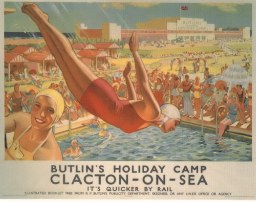 In the drab post-war years of mainland Britain the camps promised and delivered a world far removed from anything most people had experienced before. The brightly coloured buildings with exotic names, the seemingly endless list of entertainment and activities, the wonderful flower gardens, and all available for the equivalent of a weeks pay.
In the drab post-war years of mainland Britain the camps promised and delivered a world far removed from anything most people had experienced before. The brightly coloured buildings with exotic names, the seemingly endless list of entertainment and activities, the wonderful flower gardens, and all available for the equivalent of a weeks pay.
So what were the old camps like in their heyday?
The camps were like mini towns, in some cases spread over 200 acres, and were virtually self sufficient. They were eventually equipped with shopping arcades, indoor and outdoor pools, a whole range of sporting and entertainment facilities, a fairground, a host of bars and discos, professional theatre shows, amusement arcades, boating lakes and even churches. They also boasted hairdressing salons, newsagents, betting shops, launderettes and post offices. Some camps had chairlifts, miniature railways, water skiing and even monorails. It was quite possible for a family to remain on Butlins soil for the entire duration of their trip, and many did. The best part was that most of these activities were free and Butlins pioneered the use of all-in-one admission in Britain, something which was unheard of back then. Many people marveled at the fact that you could spend all day enjoying these facilities at no extra cost.
What's this special Butlins magic that I've heard all about?
 It was different for both adults and children but for everyone concerned the Butlin camps were indeed truly magic. For kids, to be able to go off from your parents, to explore on your own, to be able to meet new friends, to go swimming, to go to the fairground or chairlift, to visit the theatre, play sports and to just have that whole freedom was truly awesome. And having all that land to explore and those buildings to investigate was something quite extraordinary. And the best part? It was all free! You didn't have to keep begging mum and dad for more money. And for parents it gave them a wonderful relaxing break from the kids. Hordes of daytime and evening activities to keep them occupied and secure in the knowledge that the children were busy (and safe) elsewhere. It really was a unique and magical experience.
It was different for both adults and children but for everyone concerned the Butlin camps were indeed truly magic. For kids, to be able to go off from your parents, to explore on your own, to be able to meet new friends, to go swimming, to go to the fairground or chairlift, to visit the theatre, play sports and to just have that whole freedom was truly awesome. And having all that land to explore and those buildings to investigate was something quite extraordinary. And the best part? It was all free! You didn't have to keep begging mum and dad for more money. And for parents it gave them a wonderful relaxing break from the kids. Hordes of daytime and evening activities to keep them occupied and secure in the knowledge that the children were busy (and safe) elsewhere. It really was a unique and magical experience.
What were the chalets like?
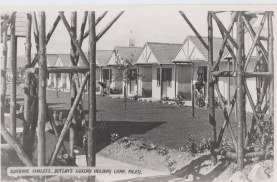 When talking of old chalets most people tend to think of the little 10ft square buildings with their plaster walls and apex roofs. Although a lot of these were built in the early camps the majority were contained within long single-storey blocks with brick walls and asbestos roofing. Two-storey structures started appearing in the 1950s but many of the these original chalets lasted well into the 1980s.
When talking of old chalets most people tend to think of the little 10ft square buildings with their plaster walls and apex roofs. Although a lot of these were built in the early camps the majority were contained within long single-storey blocks with brick walls and asbestos roofing. Two-storey structures started appearing in the 1950s but many of the these original chalets lasted well into the 1980s.
All of the early chalets were pretty basic and consisted of nothing more than a bed, wardrobe and sink with cold running water. Heating and carpeting was not considered necessary and jugs were provided to fetch hot water from a nearby tap. Toilet and bathroom facilities were provided in huge communal washrooms and if you fancied an early morning cuppa you could take your flask to the restaurant the evening before and get it filled. However by the early '60s all the chalets had been equipped with hot running water and some even had heating and private bathrooms - available for an extra charge!
Today's Butlins chalets ('apartments') are very luxurious by comparison and even the most basic now feature en-suite bathrooms and televisions as standard. In fact the new 'Deluxe' half-board rooms have wide-screen TVs, video and DVD players, in-room safes, hair dryers, a personal parking space, balcony or terrace, free wine and chocolates on arrival and even a second TV in the bedroom!
So what did people do for food?
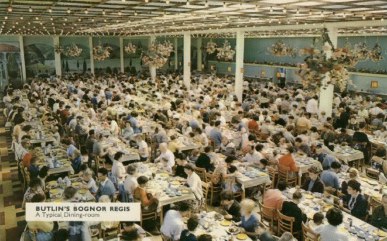 Up until the late 1960s the only option was full-board. At some of the larger camps it was quite possible for 10,000 people to be staying on site at any one time and all of these had to be fed 3 meals day. Each camp had two or more cavernous dining halls and two sittings were arranged for each meal, usually an hour apart, with campers being allocated a time and table for either the first or second sitting. The menu wasn't particularly extensive but everyone could be fed within the hour and cleared out ready for the next hungry batch. This feat is even more impressive when you consider that some of the dining halls could seat a thousand people - and some camps had four of them! The larger camps could easily serve over 200,000 meals per week, all cooked and prepared on site and and hand delivered by a fleet of waiters and waitresses.
Up until the late 1960s the only option was full-board. At some of the larger camps it was quite possible for 10,000 people to be staying on site at any one time and all of these had to be fed 3 meals day. Each camp had two or more cavernous dining halls and two sittings were arranged for each meal, usually an hour apart, with campers being allocated a time and table for either the first or second sitting. The menu wasn't particularly extensive but everyone could be fed within the hour and cleared out ready for the next hungry batch. This feat is even more impressive when you consider that some of the dining halls could seat a thousand people - and some camps had four of them! The larger camps could easily serve over 200,000 meals per week, all cooked and prepared on site and and hand delivered by a fleet of waiters and waitresses.
It was a major operation and Butlins became experts in the slick and efficient way it undertook this huge example of mass catering. Whole teams of chefs, kitchen staff and waiters worked flat out to keep the food coming. They were helped by huge heated food trolleys and massive industrial machinery such as mechanical potato peelers and dishwashers which could handle 8,000 plates an hour. It's no wonder the Army turned to Billy Butlin for help in feeding the troops during the second world war!
Here's an extract of the Butlin shopping list for a typical year in the early 1960s:
3.5 million eggs
100 tons of sausages (would stretch for 217 miles)
120,000 gallons of soup (enough for 4 million portions)
1,570 tons of potatoes (216 acres of crops)
34 tons of tea (enough for over 20 million cups)
240 tons of pork chops (requiring over 8,000 pigs!)
Although many of todays visitors opt for self-catering Butlins still offers a half board option (breakfast and evening dinner). The whole process has been modernised though with flexible eating times and a more relaxed approach which includes wide-ranging self serve buffets complete with international and vegetarian options.
Didn't the dining halls compete with each other?
Yes, to encourage the competitive spirit there were a number of Redcoats allocated to each dining hall (or House) and they were led by the Redcoat House Captain whose task it was to encourage the campers to enter the numerous competitions available. House Points were awarded to winners and runners-up in every weekly competition and the House with the most points at the end of the week would win the Inter-House Trophy. There was always great rivalry between Redcoats and campers alike.
Similarly, there was a Redcoat House Chairman (usually an older Redcoat) and he/she would obtain volunteers from each Dining Hall to form the weekly Campers Committee. This Committee would meet periodically through the week to air any complaints or suggestions raised by campers and they were immensely valuable as judges in the many competitions.
What about self catering?
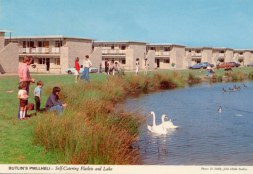 Billy Butlin was always against this idea and insisted that people went on holiday to escape the chores of cooking and cleaning. But after his retirement, and after seeing the success of the conversions carried out by Pontins, Bobby Butlin decided to introduce self catering in a big way. Starting in the late 1960s whole rows of back-to-back chalets were enlarged by knocking at least four separate units into one thus providing a kitchen & dining area, bathroom & toilet, lounge with TV and one or two bedrooms. The settee in the lounge could become another bed if required. A number of brand new self catering blocks were also built. But plenty of the half-board rooms still remained to give campers a choice.
Billy Butlin was always against this idea and insisted that people went on holiday to escape the chores of cooking and cleaning. But after his retirement, and after seeing the success of the conversions carried out by Pontins, Bobby Butlin decided to introduce self catering in a big way. Starting in the late 1960s whole rows of back-to-back chalets were enlarged by knocking at least four separate units into one thus providing a kitchen & dining area, bathroom & toilet, lounge with TV and one or two bedrooms. The settee in the lounge could become another bed if required. A number of brand new self catering blocks were also built. But plenty of the half-board rooms still remained to give campers a choice.
Some of the old dining halls were then converted into other uses, including self serve restaurants which enabled those on self catering to choose when and where to eat. Each camp also had its own supermarket which allowed campers to buy their supplies on site. The popularity of self-catering meant that fewer people were now taking the full-board option so this allowed the company to introduce single meal sittings and to focus more on quality instead of quantity. Altogether self catering was a highly successful move and still makes up a good proportion of today's visitors.
So what camp attractions were available in the early days?
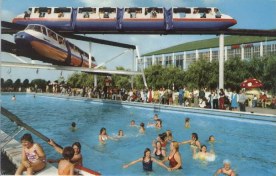 Although the early camps lacked a lot of the later features, you still had plenty to keep you occupied - lots of sporting activities, the outdoor heated pool, kids play area, boating lake and a good range of bars, theatres and entertainment venues. And not forgetting the organised entertainment provided by the ever enthusiastic Redcoats! During the '50s and '60s the company invested over £10 million into the camps which resulted in bigger and better facilities such as indoor pools, fairgrounds, chairlifts and monorails. A good percentage went towards the construction of some new entertainment venues along with the improvement of some older buildings.
Although the early camps lacked a lot of the later features, you still had plenty to keep you occupied - lots of sporting activities, the outdoor heated pool, kids play area, boating lake and a good range of bars, theatres and entertainment venues. And not forgetting the organised entertainment provided by the ever enthusiastic Redcoats! During the '50s and '60s the company invested over £10 million into the camps which resulted in bigger and better facilities such as indoor pools, fairgrounds, chairlifts and monorails. A good percentage went towards the construction of some new entertainment venues along with the improvement of some older buildings.
What were the bars and pubs like?
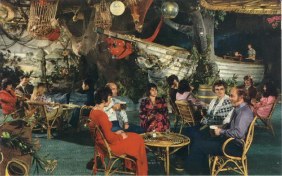 Each camp featured a wide selection of different bars and entertainment venues, each with its own unique atmosphere. Probably the most famous were the Beachcomber Bars which started appearing at all the camps during the early 1960s. The layout was based around a Hawaiian beach scene with waterfalls and bridges and a "volcano" which erupted once an hour. Others included the Crazy Horse Saloon (complete with Wild West paraphernalia), the Pig & Whistle (with its famous revolving bar), the Regency and the French. In fact the bar counter in the French Bar at Filey was once the longest in the UK, measuring nearly 200 feet and requiring up to 70 staff to operate. These statistics held pride of place in the Guinness Book of Records for many years.
Each camp featured a wide selection of different bars and entertainment venues, each with its own unique atmosphere. Probably the most famous were the Beachcomber Bars which started appearing at all the camps during the early 1960s. The layout was based around a Hawaiian beach scene with waterfalls and bridges and a "volcano" which erupted once an hour. Others included the Crazy Horse Saloon (complete with Wild West paraphernalia), the Pig & Whistle (with its famous revolving bar), the Regency and the French. In fact the bar counter in the French Bar at Filey was once the longest in the UK, measuring nearly 200 feet and requiring up to 70 staff to operate. These statistics held pride of place in the Guinness Book of Records for many years.
Although different from the past, Butlins still have a good selection of different themed pubs and bars.
What were Quiet Lounges?
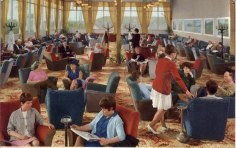 These were simply rooms were people could go for a quiet read or chat. Some of the walls were adorned with paintings which had been purchased over the years by Billy Butlin, usually at knock down prices. However this art collection gradually increased in value and eventually became valued at several million pounds! There were also TV lounges, one for the BBC and the other for ITV. At the time chalets did not have their own televisions so people would flock to their favourite room to catch up on the latest news and entertainment.
These were simply rooms were people could go for a quiet read or chat. Some of the walls were adorned with paintings which had been purchased over the years by Billy Butlin, usually at knock down prices. However this art collection gradually increased in value and eventually became valued at several million pounds! There were also TV lounges, one for the BBC and the other for ITV. At the time chalets did not have their own televisions so people would flock to their favourite room to catch up on the latest news and entertainment.
What about the theatres?
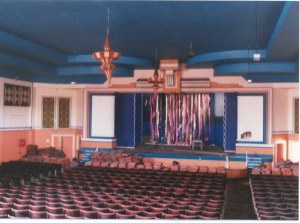 Each camp had one or two theatres along with smaller venues hosting children's shows, film shows and talent competitions. Some of the main theatres were huge, seating 2,000 or more people, and boasted superb 'West End' style facilities. Infact, the Gaiety Theatre at Filey, built in around 1960, was the largest theatre in Europe seating 3,000 on one floor. A lot of the shows were highly professional and many later stars of TV and stage had their first taste of fame here. Shows were run throughout the day although the main events were always scheduled for the evenings. The 'Sunday Night Showtime' became one of the big events with top line stars brought in to entertain. Other shows included those by the resident repertory company, Redcoat shows, talent contests and even some highbrow entertainment in the form of visiting operatic and ballet companies.
Each camp had one or two theatres along with smaller venues hosting children's shows, film shows and talent competitions. Some of the main theatres were huge, seating 2,000 or more people, and boasted superb 'West End' style facilities. Infact, the Gaiety Theatre at Filey, built in around 1960, was the largest theatre in Europe seating 3,000 on one floor. A lot of the shows were highly professional and many later stars of TV and stage had their first taste of fame here. Shows were run throughout the day although the main events were always scheduled for the evenings. The 'Sunday Night Showtime' became one of the big events with top line stars brought in to entertain. Other shows included those by the resident repertory company, Redcoat shows, talent contests and even some highbrow entertainment in the form of visiting operatic and ballet companies.
All the traditional old Butlin theatres have now gone but their place has been taken with huge cabaret type venues with highly professional lighting and sound systems and able to accommodate up to 2,000 people. Each camp also has its own cinema showing the latest releases.
And the ballrooms?
Ballrooms were always a major part of Butlin life and each camp had a good selection to choose from. Various interests were catered for in the form of Modern, Old Time or Jive and each had it's own separate facility. Each ballroom also had it's own resident band and competitions were held throughout the summer with grand finals being held at the end of the season, usually in London at the Royal Albert Hall. The largest event was the Butlin's Dance Festival which was recognised as the biggest in the world, would take-over a camp as an exclusive booking at the end of season and enjoy up to 10,000 dancers, supporters and officials for a week with different types of dance taking place simultaneously in the various ballrooms and theatres on the camp. Other contests included Highland Dancing, Modern, Old Time, Novice, the Veleta Trophy and even Tap Dancing.
What's all this about the loudspeakers and that infamous 'wakey-wakey' call?
 All of the camps and hotels had an extensive network of loudspeakers supplied by the London company of Tannoy Ltd. They were operated by staff from Radio Butlin and were used to broadcast both announcements and music. But probably their most memorable purpose was to wake the campers every morning. At a certain time the loudspeakers would suddenly burst into life with the famous 'wakey-wakey' call and music would be played to let everyone know that the first sitting for breakfast was coming up. The early campers at Ayr probably had the worse deal as they endured a wake-up call in the form of a local bagpipist! The Tannoy system was toned down in the 1970s and later scrapped altogether.
All of the camps and hotels had an extensive network of loudspeakers supplied by the London company of Tannoy Ltd. They were operated by staff from Radio Butlin and were used to broadcast both announcements and music. But probably their most memorable purpose was to wake the campers every morning. At a certain time the loudspeakers would suddenly burst into life with the famous 'wakey-wakey' call and music would be played to let everyone know that the first sitting for breakfast was coming up. The early campers at Ayr probably had the worse deal as they endured a wake-up call in the form of a local bagpipist! The Tannoy system was toned down in the 1970s and later scrapped altogether.
What was the chalet patrol service?
This was a service run by the nursery department and designed to allow parents to go out in the evening whilst the kids remained asleep in the chalets. Teams of staff would patrol the chalets (sometimes on cycles) and make a note of any from which crying babies or children could be heard. This information was then relayed on the Tannoy or back to the main entertainment buildings where a sign would flash to alert the parents.
Didn't Butlins also own hotels?
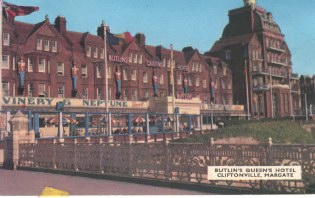 Yes in the 1950s they began acquiring hotels in Brighton, Blackpool and several in Cliftonville. In later years they were joined by further hotels in Scarborough, Llandudno, London and even Spain. The camps at Ayr and Skegness also had separate self-contained hotels within the grounds.
Yes in the 1950s they began acquiring hotels in Brighton, Blackpool and several in Cliftonville. In later years they were joined by further hotels in Scarborough, Llandudno, London and even Spain. The camps at Ayr and Skegness also had separate self-contained hotels within the grounds.
The hotels obviously didn't have the same huge range of activities as the camps but most of them still offered a selection of bars, a theatre, swimming pool, competitions and of course the Redcoats.
All the hotels were sold in 1998 but most are still open today under new ownership.
In 2003 the company announced plans to build a brand new luxury hotel at the Bognor resort, which was opened in 2005 and known as the Shoreline Hotel. This was followed in 2009 by the Ocean Hotel, with some of the old chalets being demolished as a result.
What about the Butlin badges?
The attractive little metal pin badges were introduced as a kind of ID tag to show that you were a paid-up holidaymaker. They were worn for the duration of the holiday and allowed you admission into the various entertainment venues. They first appeared in 1936 and each year (except for the war period) different badges were produced for each camp and hotel. The badges changed colour each week. For instance, on the Pwllheli 1958 badge (pictured), the outer ring could be either red, blue, green, black or yellow and for five weeks the new arrivals would have a different colour badge to the previous week's campers. This helped on two counts, Security could see whether anyone had outstayed their welcome and Bar staff could refuse to serve you if not wearing the right colour badge, helping with the Licensing Laws. Badges were also produced for a whole range of other activities including the children's clubs, the Winter reunions, sports festivals and Christmas. Badges were also given to day visitors, to those staying for a 2nd week and to members of the different social clubs and committees.
They were last produced at the end of 1967. The exact number of different badges is not known but a rough estimate is around 1,700. Most can be picked up relatively cheaply today although certain rarities command a higher price.
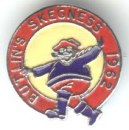
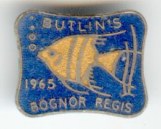

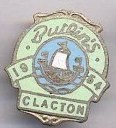
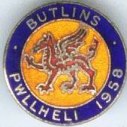
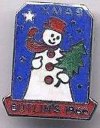
But, isn't it possible to buy badges at Butlins today?
Yes, in 2004 pin badges were launched, the idea being that guests buy badges and then attach them to a lanyard which they wear around their neck. The badges feature a variety of images including Butlins characters and old logos. Staff also wear lanyards and guests can swap their badges with staff, thereby encouraging guests and staff to interact with each other.
Some of the badges are available to buy on resort whilst others can only be obtained from swapping with staff. Special badges are also available including annual "Premier Club" badges, which are available to guests who visit Butlins more than a certain number of times, "Eat Well" and "Discovery" badges, both of which are available to guests who get cards stamped for eating certain healthy food or completing certain activities.
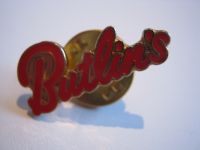
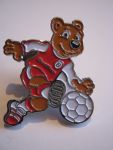
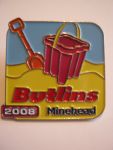
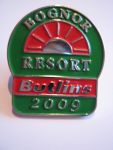
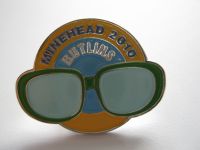

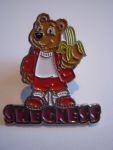
So what caused the camps to lose popularity?
By the late 1960s the camps had experienced several boom years and things were looking good for the future. Billy Butlin retired in 1968 and moved to Jersey (for tax reasons) and the company was taken over by his son Bobby. In 1972 the company was sold to Rank for £43 million although Bobby remained in control. But the entire British holiday industry was about to see some major competition from foreign destinations. People began flocking abroad in record numbers and the heady days of the British seaside resort were coming to an end. In common with most other holiday companies Butlins began seeing some major declines in bookings.
But didn't they also have an image problem?
Yes, what was fine for the post-war years was now looking very dated. The chalets in straight lines, the blaring loud speakers, the barbed wire fences, the communal bathrooms and the general air of regimentation reminded people more of a military camp than of a place of fun. Butlins began losing some of it's valued family custom and in their place came hordes of unruly teenagers. The camps also took on a rundown appearance and references to them being the 'Stag party capital of the world' certainly didn't help. The whole Butlins family image had become severely dented.
Did the company do anything to stop this slide?
The camps became known as 'centres' and changes were made to ban the single-sex bookings, to scrap the Tannoy system, to tone down the regimentation and to boost the self catering facilities. They also diversified into other holiday markets with the acquisition of some smaller holiday camps and caravan parks which they operated under the banner of Freshfield Holidays. To try and cash in on the foreign holiday craze they even bought a large 400-room hotel in Torremolinos Spain.
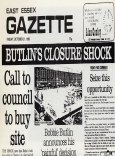 But low bookings resulted in low investment. Reports came in of leaking and damp chalets, of cold swimming pools, peeling paint, closed facilities, poor food and indifferent staff. £3 million was invested in 1978 but this was not enough to halt the decline. A major decision was made to trim down the empire and focus on a smaller number of sites. Between 1982 and 1986 four of the camps were sold (Mosney, Clacton, Filey and Barry Island) leaving just five remaining.
But low bookings resulted in low investment. Reports came in of leaking and damp chalets, of cold swimming pools, peeling paint, closed facilities, poor food and indifferent staff. £3 million was invested in 1978 but this was not enough to halt the decline. A major decision was made to trim down the empire and focus on a smaller number of sites. Between 1982 and 1986 four of the camps were sold (Mosney, Clacton, Filey and Barry Island) leaving just five remaining.
What happened to the camps that were sold?
Mosney remained open until 1999 but is now closed and used as a home for asylum seekers. Clacton and Filey were later demolished after both their new owners went bankrupt. Barry Island lasted until 1996 and has since been demolished. Mosney is therefore now the last remaining ex-Butlins camp that is still very much in it's original condition.
What happened to the five that were left?

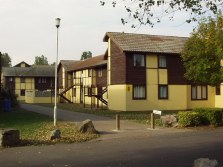 Between 1986 and 1990 a total of around £100 million was invested to try and make up for the years of neglect. The camps all received new 'Holiday World' identities with the Butlins name being used less to try and distance themselves from the past. The word 'Hi-de-Hi' was banned. The money went towards new sub-tropical indoor funpools along with new and improved accommodation, new food and restaurant facilities and a general overhaul of buildings. Rows of old chalets were torn down and replaced with new 'apartment' accommodation. Log cabins and static caravans were also added although quite a few of the old buildings and chalets still remained.
Between 1986 and 1990 a total of around £100 million was invested to try and make up for the years of neglect. The camps all received new 'Holiday World' identities with the Butlins name being used less to try and distance themselves from the past. The word 'Hi-de-Hi' was banned. The money went towards new sub-tropical indoor funpools along with new and improved accommodation, new food and restaurant facilities and a general overhaul of buildings. Rows of old chalets were torn down and replaced with new 'apartment' accommodation. Log cabins and static caravans were also added although quite a few of the old buildings and chalets still remained.
So why only three camps now?
By the late '90s the camps at Ayr and Pwllheli were still not generating the expected returns and a decision was taken to convert them into Haven caravan parks, a sister company of Butlins. The move was made to reduce overheads as Haven operate with fewer staff, facilities and attractions. Most of the chalets and buildings were demolished and replaced by several hundred caravans.
So what happened to the remaining three?
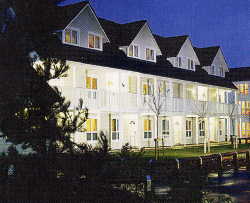 Bognor, Minehead and Skegness then received yet another new round of investment and the old 'Holiday World' identities were dropped with the Butlins name now taking prominence once again and the camps becoming known as 'resorts'. £130 million was invested over the winter of 1998/99 and again it went towards more modernisation, improved accommodation and new facilities. Each camp received a Skyline Pavilion, huge undercover areas the size of Wembley football pitch. Allowing protection from the British weather, each Pavilion houses shops, bars, restaurants and a wealth of entertainment and enables the company to provide year-round, weather-protected breaks. Over 1,000 brand new apartments were built at Skegness. Minehead received a huge new indoor swimming complex. Over 3,000 rolls of new carpet were spread around the three resorts along with 230,000 litres of paint. Every single apartment was refurbished.
Bognor, Minehead and Skegness then received yet another new round of investment and the old 'Holiday World' identities were dropped with the Butlins name now taking prominence once again and the camps becoming known as 'resorts'. £130 million was invested over the winter of 1998/99 and again it went towards more modernisation, improved accommodation and new facilities. Each camp received a Skyline Pavilion, huge undercover areas the size of Wembley football pitch. Allowing protection from the British weather, each Pavilion houses shops, bars, restaurants and a wealth of entertainment and enables the company to provide year-round, weather-protected breaks. Over 1,000 brand new apartments were built at Skegness. Minehead received a huge new indoor swimming complex. Over 3,000 rolls of new carpet were spread around the three resorts along with 230,000 litres of paint. Every single apartment was refurbished.
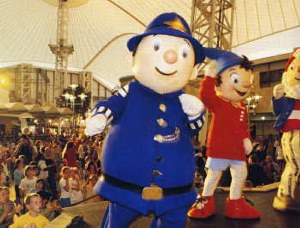 Redcoats became trained at Butlins academies of excellence and West End choreographers were brought in to direct them in lavish musical productions. Mother-in-law jokes were banned, as were beards for Redcoats, who had to adhere to "grooming guidelines". Food outlets included such famous names as Burger King and Harry Ramsden's. The company teamed up with Marvel leading to live appearances from Hulk and Spider-Man. Children's TV favourites Digimon, Power Rangers and America Wrestling entertained children in the Skyline Pavilion. Noddy and his Toyland friends were also Butlin regulars and had their own play area. Towards the end of each season a huge 7,000 seat temporary undercover Arena was erected at Minehead complete with tiered seating, state of the art sound and lighting and giant TV screens. This was used for concerts featuring a host of top name acts.
Redcoats became trained at Butlins academies of excellence and West End choreographers were brought in to direct them in lavish musical productions. Mother-in-law jokes were banned, as were beards for Redcoats, who had to adhere to "grooming guidelines". Food outlets included such famous names as Burger King and Harry Ramsden's. The company teamed up with Marvel leading to live appearances from Hulk and Spider-Man. Children's TV favourites Digimon, Power Rangers and America Wrestling entertained children in the Skyline Pavilion. Noddy and his Toyland friends were also Butlin regulars and had their own play area. Towards the end of each season a huge 7,000 seat temporary undercover Arena was erected at Minehead complete with tiered seating, state of the art sound and lighting and giant TV screens. This was used for concerts featuring a host of top name acts.
Wasn't the company recently sold again?
Yes Rank decided to sell their entire holiday business, which included Butlins, Warners, Haven and Oasis, to Bourne Leisure in September 2000 for £650 million.
What changes have been made since Bourne Leisure purchased the business?
Money is spent each year on improvements to the resorts on things such as refurbishments to the main venues at each resort, improved landscaping, high ropes courses, new adventure golf courses and various chalet refurbishments. A Spa has opened at Skegness resort, Minehead has seen changes to the Skyline Pavilion which allow it to be converted into an arena and for concerts to be held in there whilst Bognor Regis has seen two new hotels built as well as the opening of the Shoreline Conference Centre, which includes boardroom and functon room facilities. Each resort now also offers a premium dining experience with new restaurants offering the chance to eat in more upmarket surroundings for an additional charge.
What are the camps like today?
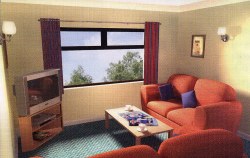 A lot of people have very fond and special memories of the old camps and some don't like the new centres due to the vast changes and the loss of that unique 'Hi-de-Hi' Butlins atmosphere. But the company is simply bringing the camps into the 21st century and it must be said that the standards of accommodation and food are now far better than anything offered in the past. The old camps were perfect for their time but they wouldn't have any place in todays market. Billy Butlin always wanted the best and most modern facilities and the new owners are simply following that same basic principle. Yes they are very different, gone are the glamorous grandmother and beauty contests. Gone are the endless free activities (although some still remain). Gone are the chairlifts and trains and monorails. Gone are the brightly coloured buildings. Hundreds of millions have been invested to bring the centres kicking and screaming into the modern age.
A lot of people have very fond and special memories of the old camps and some don't like the new centres due to the vast changes and the loss of that unique 'Hi-de-Hi' Butlins atmosphere. But the company is simply bringing the camps into the 21st century and it must be said that the standards of accommodation and food are now far better than anything offered in the past. The old camps were perfect for their time but they wouldn't have any place in todays market. Billy Butlin always wanted the best and most modern facilities and the new owners are simply following that same basic principle. Yes they are very different, gone are the glamorous grandmother and beauty contests. Gone are the endless free activities (although some still remain). Gone are the chairlifts and trains and monorails. Gone are the brightly coloured buildings. Hundreds of millions have been invested to bring the centres kicking and screaming into the modern age.
Children are entertained by familiar faces from tv such as Bob the Builder as well as by Butlins' own characters which include Billy Bear and the Skyline Gang. The Redcoats are still there, providing regular shows and helping to entertain and interact with the guests. Entertainment is also provided by various triubute acts as well as from Britains Got Talent and X-Factor finalists. Themed, adult only, weekends are also available under the brand of "Big Weekends", where adults are able to enjoy themselves without worrying about children.
The shattered image of the 70s and 80s is now just a distant memory and the new centres, albeit different from the past, look set for a long and prosperous future. Over 1 million people a year now stay at Butlins.
What did Billy Butlin do after he retired?
Billy Butlin had always been heavily involved with charitable causes and this increased upon his retirement, mainly with the Variety Club. He also established a number of business ventures in Jersey including a small holiday village and several hotels. He was knighted in 1964 and in 1972 was awarded the Variety Club's annual Humanitarian Award, being only the seventh British person to be honoured since 1938. In 1977 he suffered a heart attack but fell ill again in 1979 with stomach cancer. He died on 12th June 1980. He was buried in the cemetery of St John's Church in the north of Jersey. His headstone is engraved with an amusement park, a camp scene and the Jolly Fisherman from the famous railway poster, bearing the legend "Skegness is so bracing".
Still have a question?
Then why not ask it on our forum where someone may be able to help you!
How can I book a Butlins holiday today?
Visit the Butlins website at www.butlins.com
